Algae eaters in a tank at home isn’t just a tribute to fashion, it’s a necessity. They help fight unwanted inhabitants on tank plants, glass, decorations and substrate – yes, I’m talking about excessive algae amount in a tank. In any, even the best managed tank, there are always some algae, but usually their amount is small and they are noteless against the other higher tank plants background. When it comes to algae eaters, there are several species that are commonly regarded as effective in controlling algae growth in aquariums.
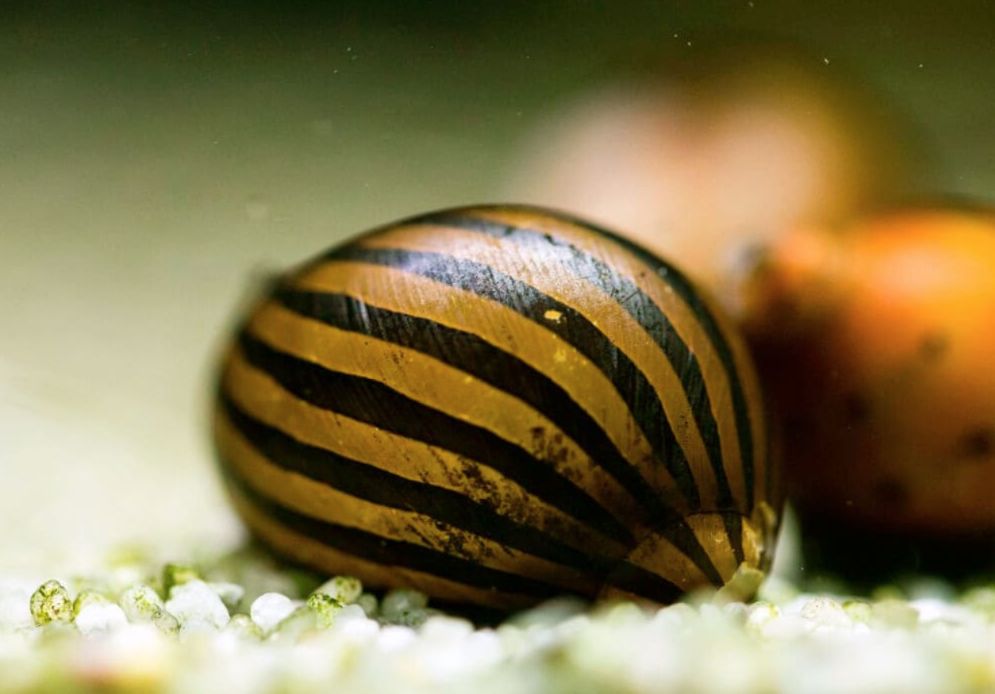
In an ordinary tank we have at home sometimes algae grow too fast and their amount becomes numerous, so because of that all the tank beauty is missing. One of the ways to solve this issue is to get some algae eaters and put them into the tank. At that it’s not necessary to be a fish (however, the majority of algae eaters are fishes), but it can also be some kind of snail or shrimp, since there are lots of types of algae eaters.
In this article we’ll tell you about the most popular and efficient tank algae fighters. These are algae eater fish and spineless species which are rather available on the market, cheap and easygoing towards their tank mates. These are the best algae eaters, which will be an ideal solution for any aquarist, for those who love tank plants and clean, transparent tank glass.
Contents
- 1 Best types of algae eaters
- 1.1 Amano Shrimp (Caridina multidentata)
- 1.2 Bristlenose Pleco (Ancistrus spp.)
- 1.3 Siamese Algae Eater (Crossocheilus oblongus)
- 1.4 Nerite Snails (Neritidae spp.)
- 1.5 Otocinclus Catfish (Otocinclus spp.)
- 1.6 Chinese Algae Eater (Gyrinocheilus aymonieri)
- 1.7 Hillstream Loach (Sewellia spp.)
- 1.8 Molly fish (Poecilia spp.)
- 1.9 Twig Catfish (Farlowella spp.)
- 1.10 Ramshorn snails (Planorbis sp.)
- 1.11 Cherry shrimp (Neocaridina davidi)
Best types of algae eaters
Amano Shrimp (Caridina multidentata)
Amano shrimp is quite popular, it can be bought in a pet shop, and it’s not a demanding shrimp. It’s quite active and gluttonous, it cleans a tank not only from algae, but also from garbage, dead tank plants remnants and feed leftovers.
These shrimps are small algae eaters, from 1 to 3 inches long, which makes them an ideal option for small tanks. They eat hair algae and its species. However, the amano shrimp doesn’t eat Black Brush Algae, Green Spot Algae, Green Dust Algae and blue-green algae. And one more thing, amano won’t feed on algae if there is lots of other more tasty and nutrient feed in a tank.
Amano shrimps efficiency against thread algae algae is inversely proportional to the shrimp size. i.e. the lager the shrimp is, the more thick algae it can swallow. That’s why the most efficient fmano shrimps are considered to be the species 1.25 or better 1.5 inches long.
If you have extra large fmano shrimps, than 5 of them will be enough to clean 45 gallons tank. If the shrimps are smaller, you’ll need more of them – there’ll be 1 shrimp for 2 gallons of a tank capacity. Also, you shouldn’t expect any help from the shrimps 1-2 cm large.
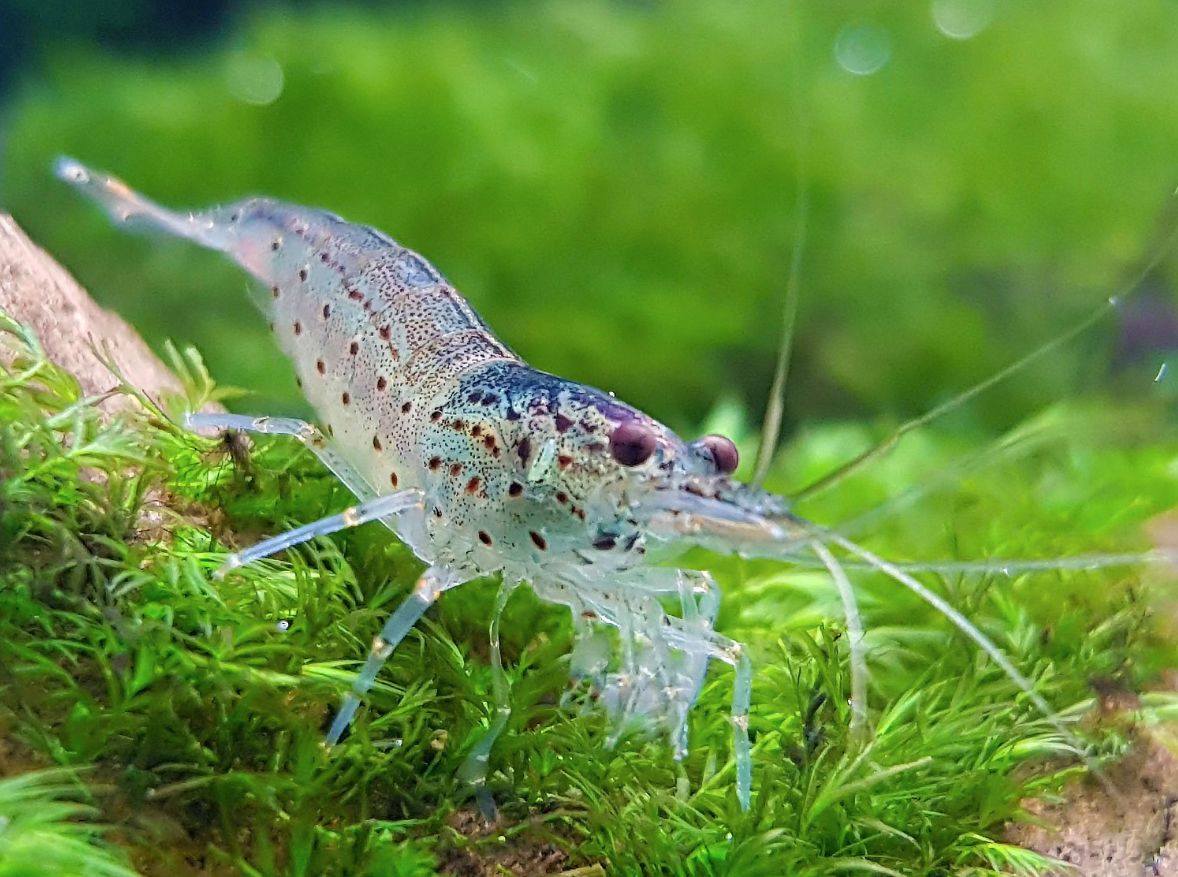
| Characteristic | Description |
|---|---|
| Scientific Name | Caridina multidentata, Caridina japonica |
| Common Name | Amano shrimp, japonica shrimp, yamato shrimp |
| Origin | Japan and Taiwan |
| Size | Approximately 2 inches (5 centimeters) in length |
| Coloration | Translucent body with brown or greenish markings |
| Behavior | Peaceful and social, often found in groups or colonies |
| Lifespan | Around 2 to 3 years in captivity |
| Diet | Algae, detritus, decaying plant matter, and small invertebrates |
| Molting | Shed their exoskeleton to grow a new one |
| Breeding | Challenging in home aquariums due to complex larval stages requiring brackish water |
| Compatibility | Generally compatible with a wide range of tank mates |
| Aquascaping | Suitable for planted tanks and aquascapes |
| Water Parameters | Neutral to slightly alkaline pH, moderate hardness |
| Temperature Range | 70°F to 80°F (21°C to 27°C) |
| Lighting | Moderate to low lighting preferred |
| Tank Size | Can be kept in aquariums as small as 5 gallons |
| Predation | Vulnerable to predation by fish, birds, and larger invertebrates |
| Environmental Role | Controls algae growth, recycles nutrients, and serves as a food source |
Bristlenose Pleco (Ancistrus spp.)
This is the most popular and spread fish among all freshwater algae eaters. The Bristlenose Pleco is rather not demanding in care and it’s quite good-looking as well, especially male fish, which has some gorgeous outgrowth on its head. It must be said, that Bristlenose Pleco fish is a rather large one and it may be 15 cm long and even more.
This algae eater food should be numerous and plant one, additionally the fish should be fed with special tablets for cat fish and some vegetables (cucumbers or marrow squash). If the fish doesn’t get enough of food, it may start eating fresh shoots of tank plants.
This Bristlenose Pleco is rather peaceful towards other tank fishes, though the fish is rather aggressive to each other, especially male fish, who guard their territory.
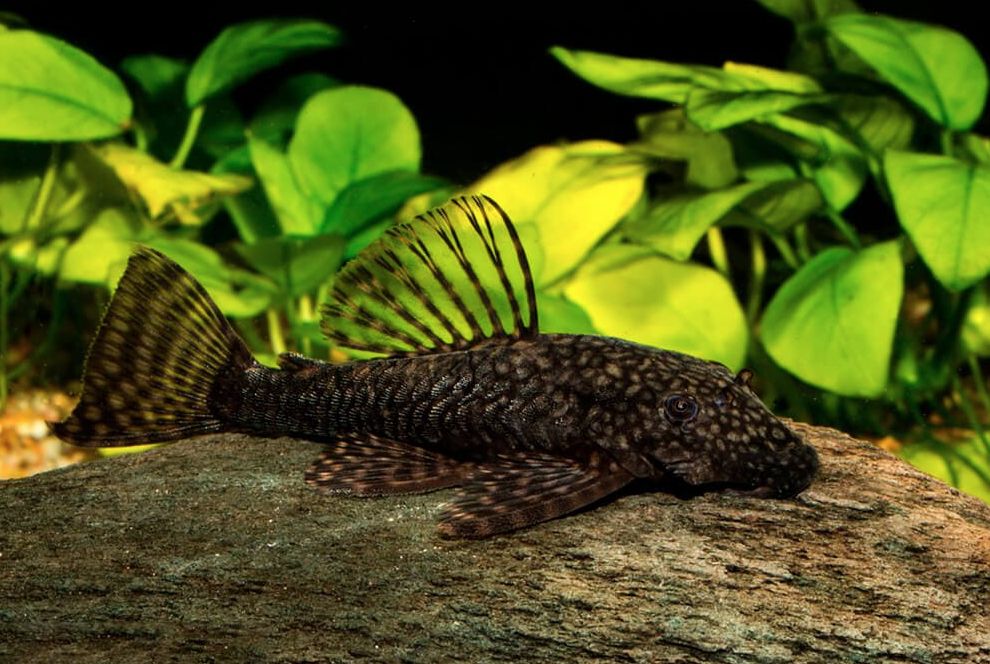
| Characteristic | Bristlenose Pleco |
|---|---|
| Maximum Size | 4-6 inches |
| Temperament | Peaceful |
| Lifespan | 5 years |
| Diet | Algae, Vegetables, Sinking Pellets |
| Tank Size | 20 gallons or larger (depending on species) |
| Water Conditions | Temperature: 72-82°F (22-28°C), pH: 6.5-7.5, Soft to moderately hard water |
| Compatibility | Generally peaceful, but males can be territorial towards each other. Compatible with most community fish, but avoid housing with aggressive or fin-nipping species. |
| Appearance | Dark brown or black body with lighter spots or patterns. Males have bristle-like tentacles on their faces. |
| Algae Control | Effective at controlling different types of algae, including green spot algae and some forms of hair algae. |
| Breeding | Relatively easy to breed in captivity. They are egg layers and tend to spawn in caves or hiding spots. |
| Special Considerations | Provide hiding spots, caves, and driftwood in the aquarium to mimic their natural habitat. Ensure a well-balanced diet with a mix of algae, vegetables, and protein-rich foods. |
Siamese Algae Eater (Crossocheilus oblongus)
This aquarium algae eater was just made for feeding on algae, since its mouth is fittest for this. If we talk about Green Spot Algae on a tank glass, sadly siamese algae eater isn’t able to do anything about it.
To keep 100 liters tank without Black Brush Algae, it’s quite enough to have 3 Siamese algae eaters in it. At that even small (3-4 cm long) Siamese algae eaters can manage this tank volume. When they grow and become longer than 4 cm, they can start eating small moss. That’s why Siamese algae eaters are totally not compatible with Java moss in a tank – they love eating it more, than algae.
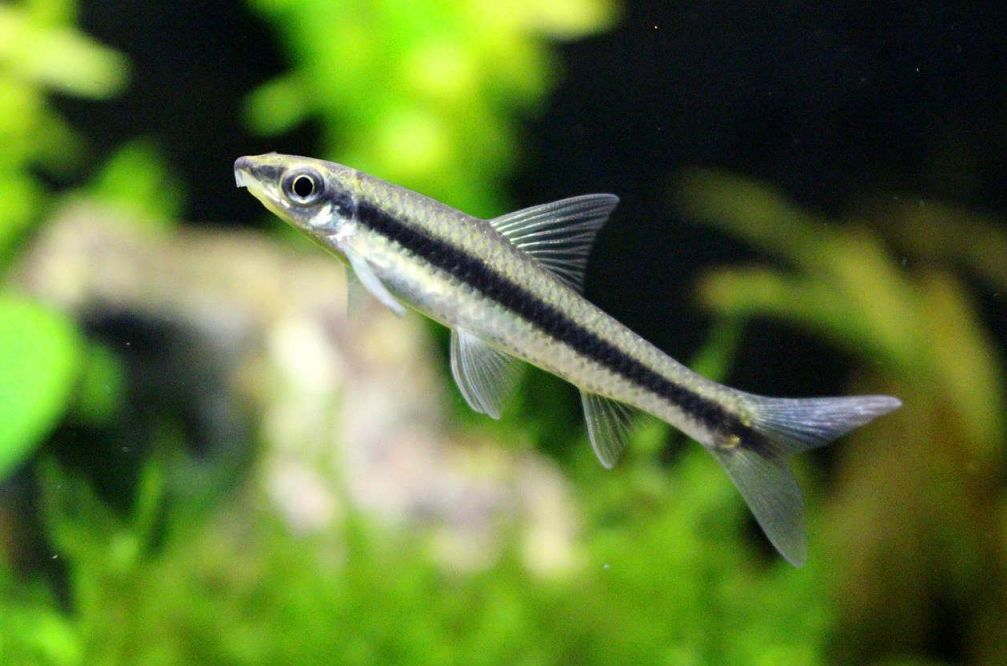
| Characteristic | Siamese Algae Eater |
|---|---|
| Maximum Size | 4-5 inches |
| Temperament | Active, semi-aggressive |
| Lifespan | 5-8 years |
| Diet | Algae (including black beard algae), sinking pellets |
| Tank Size | 20 gallons or larger |
| Water Conditions | Temperature: 72-79°F (22-26°C), pH: 6.5-7.5, Soft to moderately hard water |
| Compatibility | Can be slightly territorial with its own species but generally peaceful with other fish. Avoid housing with slow or long-finned species. |
| Appearance | Slender, silver body with a black horizontal stripe running from the snout to the tail. |
| Algae Control | Excellent at consuming different types of algae, including brush algae, black beard algae, and some green algae. |
| Behavior | Active swimmers, often seen grazing on surfaces to feed on algae. May jump if startled, so a tight-fitting lid is recommended. |
| Special Considerations | Provide ample hiding spots and areas to explore. They prefer a well-established aquarium with good water flow. They are more effective at controlling algae in their juvenile stages. |
Nerite Snails (Neritidae spp.)
Nerite snails are popular algae-eating snails that come in various patterns and colors. They are effective in consuming different types of algae and are known for their inability to reproduce in freshwater. First of all, this snail is famous for its bright, attractive coloring and small size – about 1.25 inch large. But besides this it also fights algae, including those, that other fish and snails algae eaters don’t eat.
We should mention nerite snail short life span, as a drawback and the fact that it doesn’t breed in freshwater.
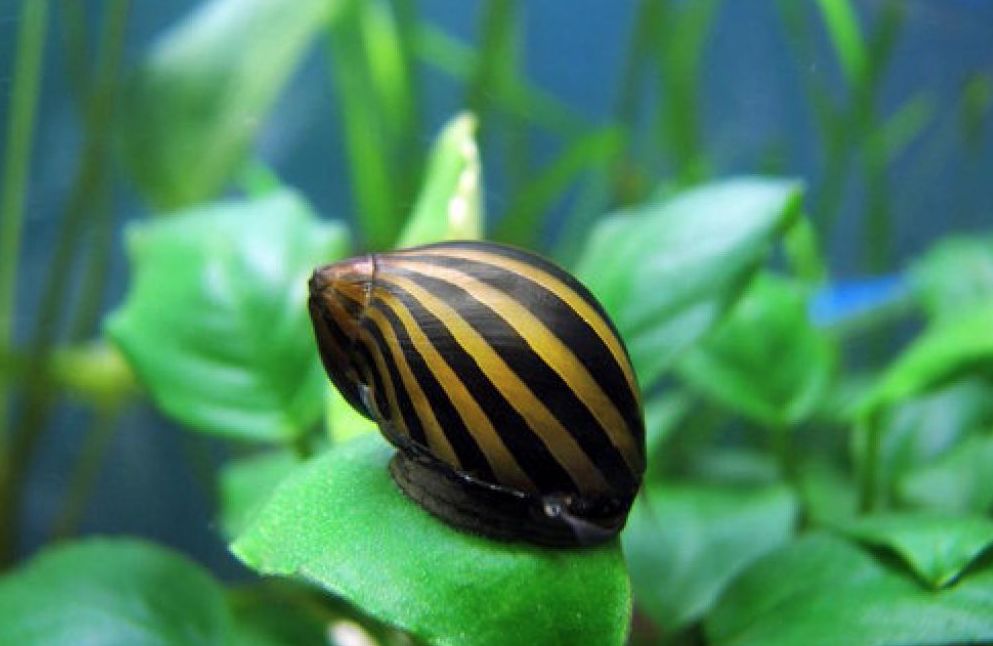
| Characteristic | Description |
|---|---|
| Size | Typically around 1 inch in length |
| Shell Shape | Round or oval-shaped |
| Shell Patterns | Varied and intricate, including zebra stripes, spots, or solid colors |
| Lifespan | 1-2 years (some individuals may live slightly longer) |
| Diet | Algae, biofilm, decaying plant matter, and uneaten food |
| Compatibility | Generally peaceful, but may be harassed by some fish species |
| Water Parameters | pH: 7.5-8.5, Temperature: 72-78°F (22-26°C) |
| Water Quality | Ammonia and nitrite levels should be kept at zero |
| Reproduction | Lay small, white, button-like eggs (often won’t hatch in freshwater) |
| Tank Environment | Require hiding spots, smooth surfaces for grazing |
| Disease Susceptibility | Generally hardy, but can be susceptible to infections or parasites |
| Genetic Variations | Different species may exhibit variations in color and pattern |
Otocinclus Catfish (Otocinclus spp.)
Otocinclus is a small, peaceful and active fish. Its size made it popular among the aquarists – it’s maximum 5 cm long. For small and not very big tanks it’s an ideal option to manage algae, since these tanks quite often suffer from uncontrolled algae growth.
However, this is a quite timid and schooling fish. It’s also rather demanding as for the tank water quality and parameters, thus we can’t recommend it to the beginners.
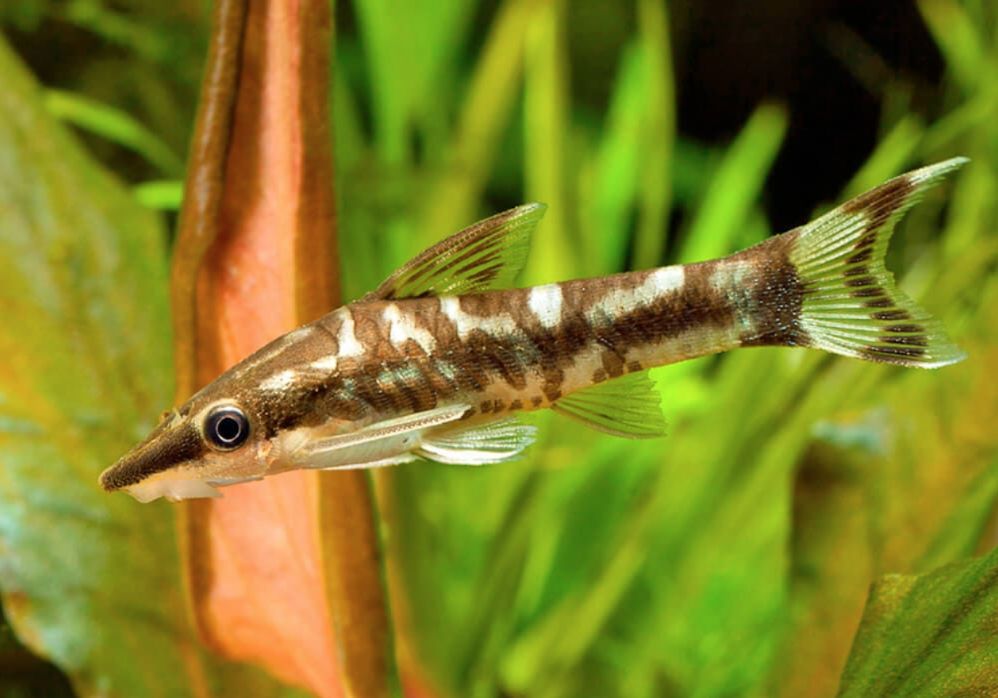
| Characteristic | Otocinclus Catfish |
|---|---|
| Maximum Size | 1.5-2 inches |
| Temperament | Peaceful |
| Lifespan | 3-5 years |
| Diet | Algae (especially soft green algae), biofilm, sinking algae wafers |
| Tank Size | 10 gallons or larger |
| Water Conditions | Temperature: 72-78°F (22-26°C), pH: 6.5-7.5, Soft to moderately hard water |
| Compatibility | Peaceful and compatible with most community fish. Keep in groups of at least 4-6 to promote natural behavior. |
| Appearance | Small, slender body with a sucker mouth. Usually, light gray or brown coloration with a distinctive black stripe along the body. |
| Algae Control | Effective at consuming soft green algae and some forms of diatoms. |
| Behavior | Largely active during the day, constantly moving and grazing on surfaces to feed on algae. |
| Special Considerations | Provide hiding spots and areas with plants or driftwood. Avoid keeping with aggressive or fin-nipping fish. Sensitive to water quality, so regular maintenance and water changes are important. |
Chinese Algae Eater (Gyrinocheilus aymonieri)
Chinese algae eater is a typical representative of algae eaters fish, it inhabits in fast rivers and it’s got used to scrape off hard fouling from stones. It’s a large fish and, unfortunately, it is quite a quarrelsome one.
It fights not only with fish of its kind, but also with other tank mates, especially if they are alike in appearance. Old Chinese algae eaters stop eating algae and start eating live feed or they attack large fishes and eat their scales.
It’s important to note that the Chinese Algae Eater (Gyrinocheilus aymonieri) is often mistakenly sold as an effective algae eater for aquariums. While they do consume algae when young, they tend to shift towards a more carnivorous diet as they mature, and their effectiveness at controlling algae decreases. Their territorial and aggressive nature makes them unsuitable for most community tanks, and they can become problematic tank mates for other fish. Careful consideration should be given before adding Chinese Algae Eaters to an aquarium.
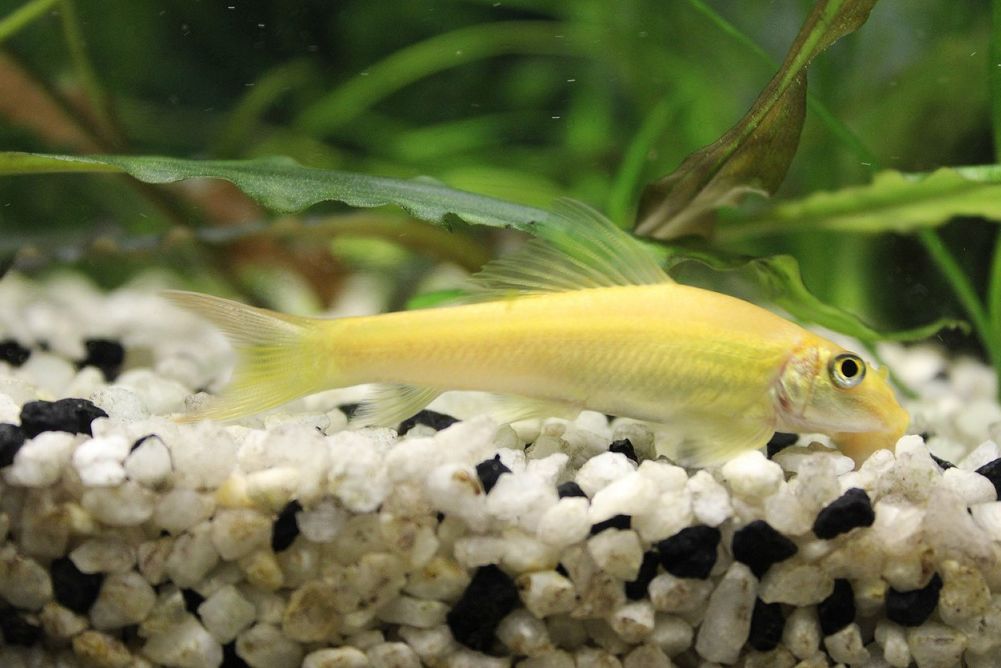
| Characteristic | Chinese Algae Eater |
|---|---|
| Maximum Size | 6-10 inches |
| Temperament | Aggressive and territorial |
| Lifespan | 5-10 years |
| Diet | Algae (when young), but shift towards a more carnivorous diet as they mature. May consume fish slime coats and exhibit fin-nipping behavior. |
| Tank Size | 30 gallons or larger (to accommodate their size) |
| Water Conditions | Temperature: 72-79°F (22-26°C), pH: 6.5-7.5, Soft to moderately hard water |
| Compatibility | Can become aggressive towards other fish, especially as they mature. Not suitable for community tanks, particularly with slow-moving or long-finned fish. |
| Appearance | Slender, elongated body with a brown or olive coloration. As they mature, they develop a golden hue on their body and a distinctive black stripe running along the lateral line. |
| Algae Control | While they consume algae when young, their effectiveness as algae eaters decreases as they mature. They may primarily feed on fish food and neglect algae. |
| Behavior | Can be active swimmers, but also spend time clinging to surfaces using their sucker-like mouth. May jump if startled, so a tight-fitting lid is recommended. |
| Special Considerations | Avoid keeping them with fish species that have long fins or slow movement. Be cautious about their territorial behavior as they may harass tankmates. Consider their long-term size and care requirements. |
Hillstream Loach (Sewellia spp.)
Hillstream Loaches are unique and fascinating fish that are well-adapted to fast-flowing streams and rivers. They are valued for their ability to graze on algae and contribute to the overall cleanliness of the aquarium. Their streamlined body shape and specialized mouthparts make them excellent climbers and algae eaters. It’s important to replicate their natural habitat by providing strong water flow, oxygenation, and suitable hiding spots.
While Hillstream Loaches are generally peaceful, it’s important to ensure compatibility with other fish species and avoid housing them with aggressive or fin-nipping tankmates. Regular water changes and maintenance are essential for their well-being, as they are sensitive to poor water quality.
Supplementing their diet with sinking algae wafers or blanched vegetables will help provide a balanced nutrition in addition to their natural algae grazing. By providing a suitable environment and proper care, Hillstream Loaches can thrive in a well-maintained aquarium.
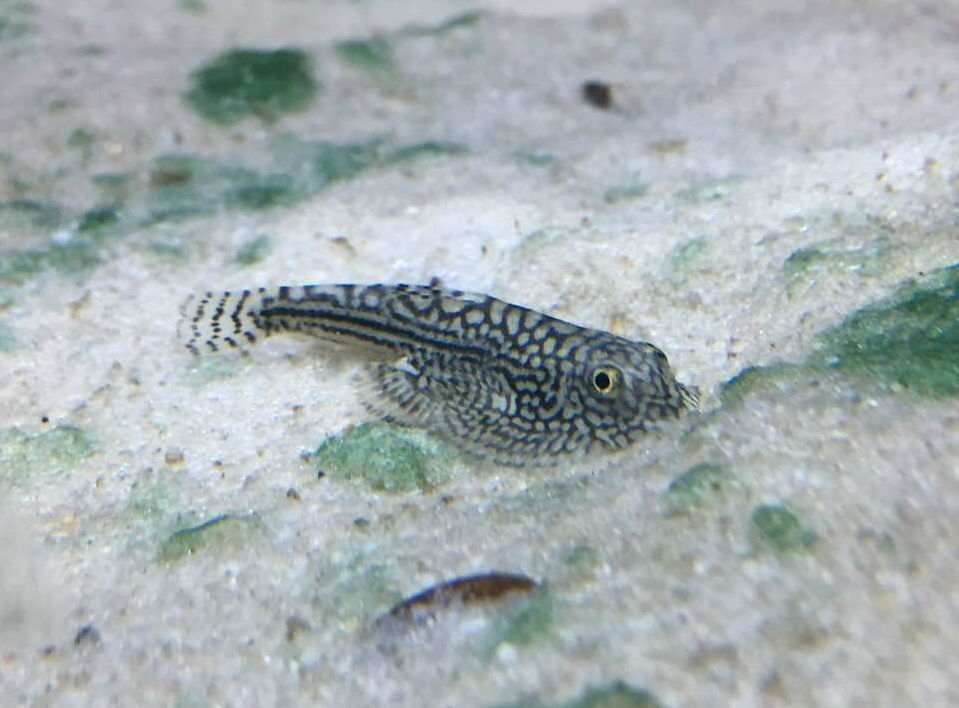
| Characteristic | Hillstream Loach |
|---|---|
| Maximum Size | 2-4 inches (depending on the species) |
| Temperament | Peaceful and active |
| Lifespan | 5-8 years (can vary) |
| Diet | Herbivorous. Feed on algae, biofilm, and small invertebrates. Supplement with sinking algae wafers or blanched vegetables |
| Tank Size | 20 gallons or larger (to provide sufficient swimming space and water flow) |
| Water Conditions | Temperature: 68-77°F (20-25°C), pH: 6.5-7.5, Soft to moderately hard water |
| Compatibility | Generally peaceful and compatible with other non-aggressive fish species. Avoid housing them with fin-nipping or overly territorial tankmates |
| Appearance | Streamlined body with a flattened ventral side. Patterns and coloration vary depending on the species, ranging from mottled brown to black with intricate markings |
| Algae Control | Effective at consuming diatoms, soft green algae, and other forms of algae that grow in fast-flowing water |
| Behavior | Active and adapted to fast-flowing water environments. They are excellent climbers and have specialized mouthparts for grazing on surfaces |
| Special Considerations | Provide strong water flow and oxygenation in the aquarium to mimic their natural habitat. Include flat rocks, smooth substrates, and driftwood to create suitable hiding spots. Avoid keeping them in slow-moving or stagnant water conditions |
Molly fish (Poecilia spp.)
They are not as demanding, as the types of algae eaters mentioned above. The molly fish eats all types of hair algae and even a thin crust on a tank glass. However, their efficiency isn’t very high if compared to Siamese algae eaters, Chinese algae eaters and large amano shrimps. Nevertheless, mollies are kept in tanks with plants, because they are always on sale, which is important if it is urgent (algae outbreak in a tank).
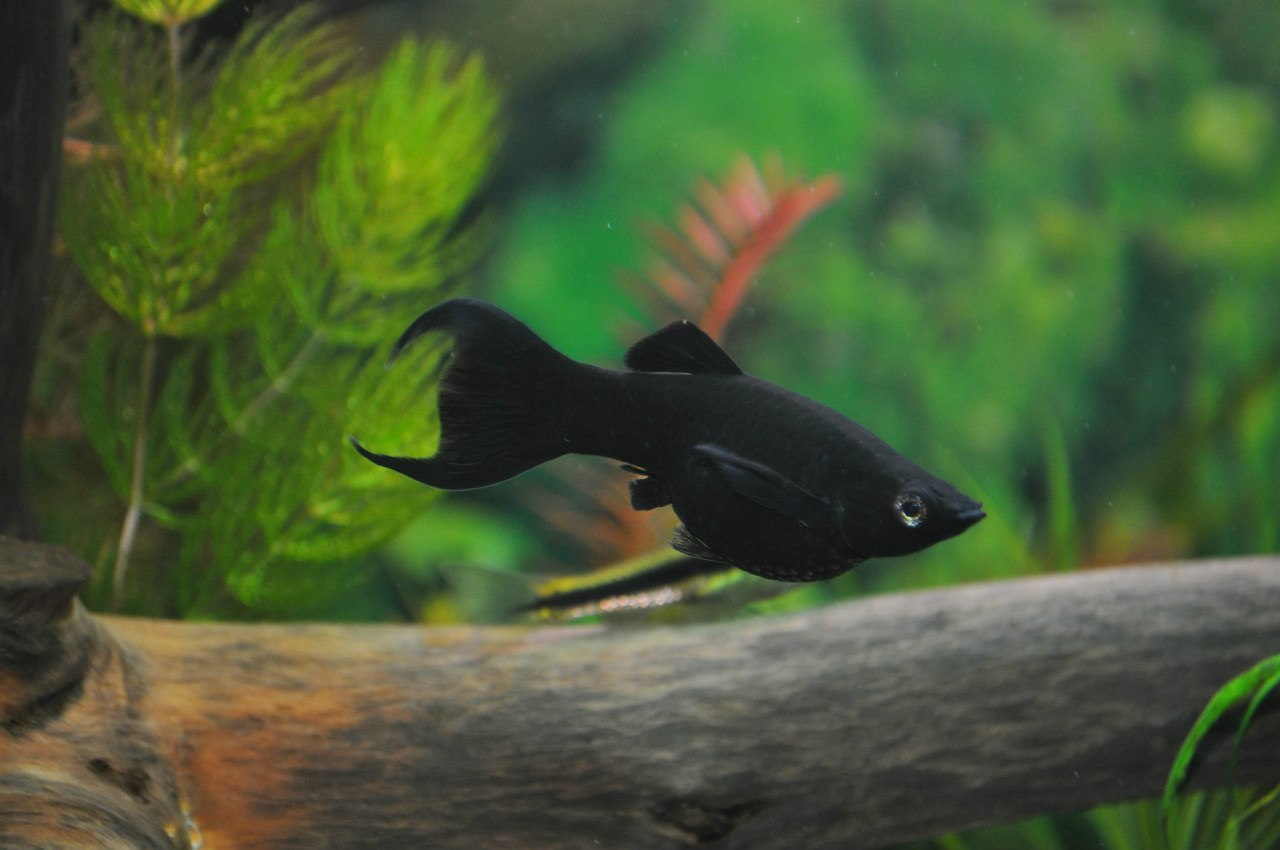
| Characteristic | Molly Fish |
|---|---|
| Maximum Size | 2-4 inches (depending on the species and variety) |
| Temperament | Generally peaceful, but males can be slightly aggressive towards each other or other fish with long fins |
| Lifespan | 2-5 years (can vary) |
| Diet | Omnivorous, primarily herbivorous. Require a varied diet including high-quality flakes, pellets, vegetables, and occasional live or frozen foods |
| Tank Size | 20 gallons or larger (to provide adequate swimming space) |
| Water Conditions | Temperature: 72-82°F (22-28°C), pH: 7.0-8.5, Hard water preferred |
| Compatibility | Generally compatible with other peaceful community fish, but avoid housing them with fin-nipping or aggressive species |
| Appearance | Various color variations and patterns available. Typically have a sleek, elongated body shape with a triangular dorsal fin |
| Breeding | Livebearers, meaning they give birth to live fry. Males have a modified anal fin called a gonopodium used for fertilization |
| Behavior | Active swimmers that occupy various levels of the aquarium. They may nip at plants, so hardy plant species or artificial decorations are recommended |
| Special Considerations | Provide plenty of hiding spots and plants for them to explore and seek shelter. Mollies prefer a well-maintained aquarium with stable water conditions. They may benefit from the addition of some salt to the water (check species-specific requirements) |
Twig Catfish (Farlowella spp.)
Twig Catfish are fascinating and unique additions to freshwater aquariums. They are known for their excellent algae-eating capabilities and their resemblance to twigs or branches. It’s important to provide a well-established aquarium with sufficient hiding spots and plants to mimic their natural environment. Additionally, these catfish may require supplemental feeding with sinking pellets or blanched vegetables if there is limited algae growth in the aquarium. They are generally peaceful, but it’s advisable to avoid housing them with aggressive or fin-nipping species.
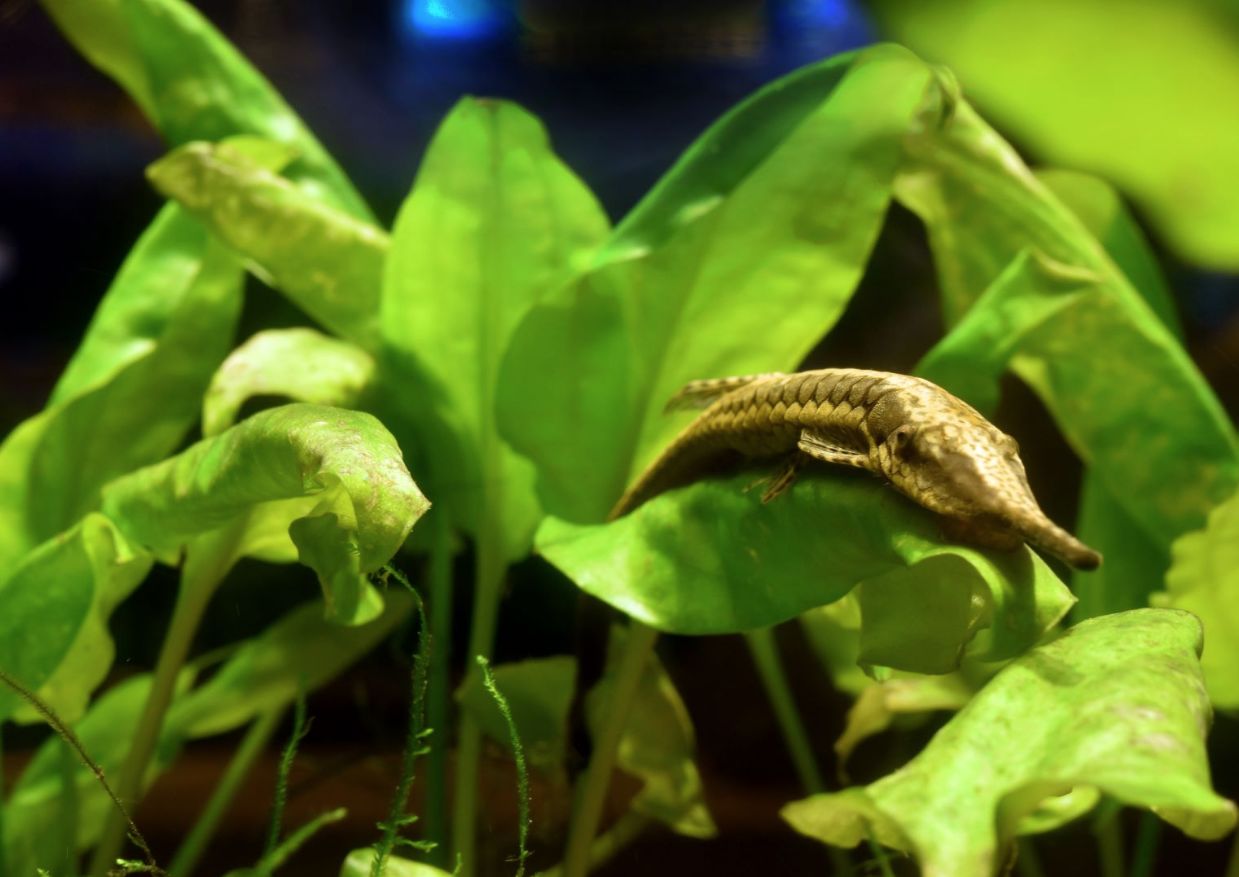
| Characteristic | Twig Catfish |
|---|---|
| Maximum Size | 4-10 inches (depending on the species) |
| Temperament | Peaceful and shy |
| Lifespan | 5-10 years (can vary) |
| Diet | Herbivorous. Primarily feed on algae and biofilm, but may accept sinking pellets or blanched vegetables |
| Tank Size | 30 gallons or larger (to provide ample swimming and hiding space) |
| Water Conditions | Temperature: 72-79°F (22-26°C), pH: 6.5-7.5, Soft to moderately hard water |
| Compatibility | Generally peaceful and compatible with other non-aggressive fish species. Avoid keeping them with fin-nipping or overly aggressive tankmates |
| Appearance | Elongated, slender body with a twig-like appearance. Camouflage coloration with patterns that mimic their natural habitat |
| Algae Control | Effective at consuming various types of algae, including diatoms and soft green algae |
| Behavior | Nocturnal and shy. They spend much of their time clinging to surfaces or resting on plants. They may be territorial towards their own species, especially males |
| Special Considerations | Provide plenty of hiding spots, such as driftwood or dense vegetation. They may require a higher oxygen level in the aquarium due to their body shape. Tankmates should be chosen carefully to ensure peaceful coexistence |
Ramshorn snails (Planorbis sp.)
Ramshorn snail is one of the most spread, simple in care and fruitful aquarium snails. Sometimes some aquarists say that is also eats tank plants, but it’s not true. It’s jaws are rather weak to bite hard leaves of higher plants. However, as for microalgae they are very efficient, although it’s not very obvious objectively.
At least, my observation is, that in a tank with juveniles there’s less algae if there are some Ramshorm snails in it. Besides, they feed quite well on food leftovers and this way keep the tank clean.
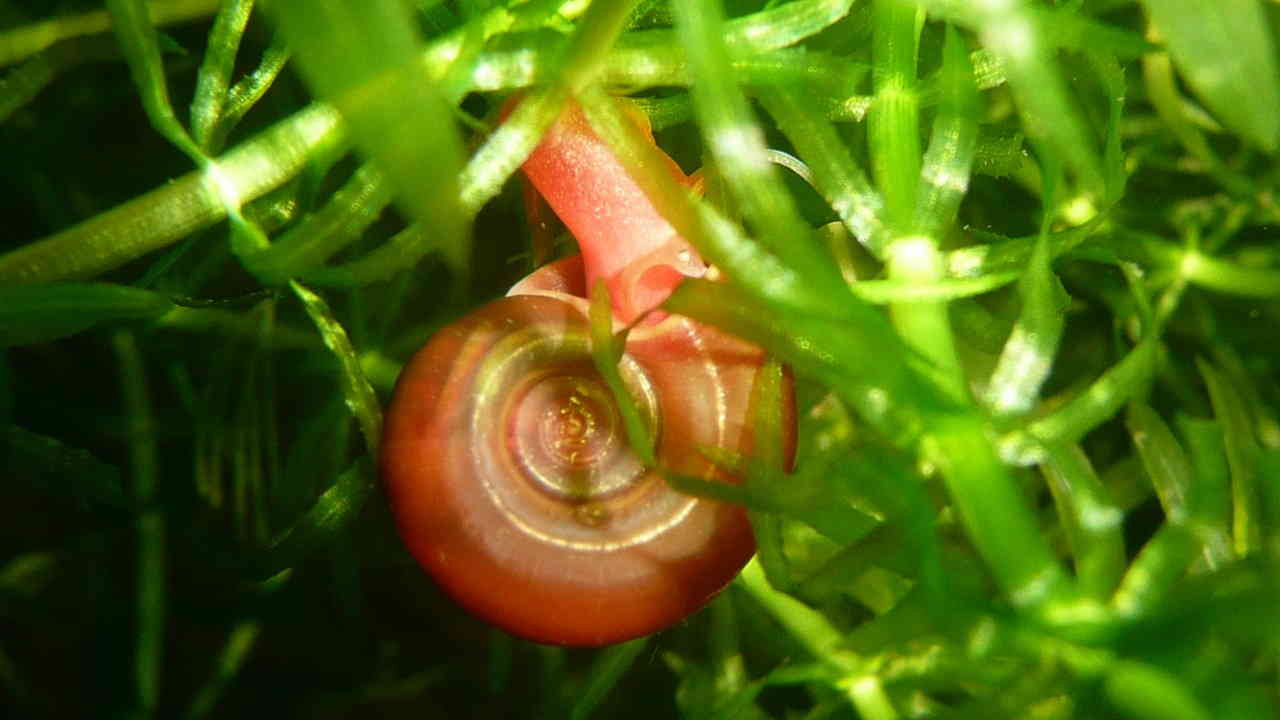
| Characteristic | Description |
|---|---|
| Family | Planorbidae |
| Size | 1/4 inch to 1 inch (0.6 cm to 2.5 cm) in shell diameter |
| Shell Shape | Coiled spiral |
| Shell Color | Varies (brown, red, translucent) |
| Body Structure | Soft, elongated body with a muscular foot |
| Lifespan | Typically 1 to 2 years |
| Habitat | Freshwater habitats such as ponds, lakes, and slow streams |
| Feeding Behavior | Herbivorous, feeding on decaying plant matter and algae |
| Reproduction | Hermaphroditic, laying eggs in clusters or gelatinous masses |
| Environmental Tolerance | Adaptable to a range of water conditions |
| Predators | Fish, turtles, water birds, and some invertebrates |
| Ecological Role | Helps in nutrient cycling, algae control, and detritus removal |
| Benefits in Aquariums | Cleans up organic debris, contributes to a balanced ecosystem |
Cherry shrimp (Neocaridina davidi)
Cherry shrimp is the most spread one among aquarists, since it breeds easily. Small shrimps, 0.5-1 inch long are efficient towards algae mainly due to their large number in a tank (one or more shrimps for 1 liter of tank capacity). As well as Amano shrimps, cherrry shrimp prefers hair algae.
Considering their small size they can eat only some kinds of soft algae, such as Rhizoclonium, for example. These shrimps are irreplaceable when starting a planted tank. The shrimp actively feeds on rotten leaves of newly planted greenery and fights Rhizoclonium, which almost always appears during the 1st month of planted tank existence and it can sufficiently slow down the growth of tank pants by covering them completely.
Usually cherry srimp plays the main part in processing of feed leftovers in a settled tank, thereby it keeps the tank balance and prevents snails excessive breeding.
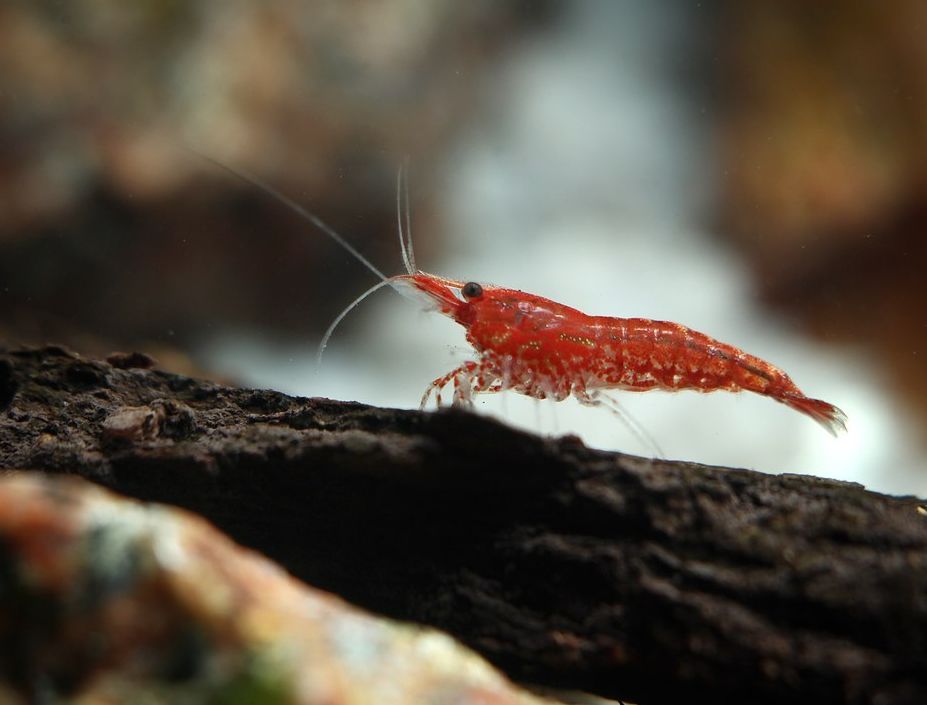
| Characteristic | Description |
|---|---|
| Scientific Name | Neocaridina davidi |
| Common Names | Cherry shrimp, Red cherry shrimp, RCS |
| Maximum Size | Approximately 1 inch (2.5 cm) |
| Lifespan | 1 to 2 years (can vary based on care and environmental factors) |
| Color Variations | Red |
| Body Shape | Compact and elongated |
| Antennae | Long, thin, and highly sensitive |
| Gender Differences | Males are generally smaller and more slender than females |
| Behavior | Peaceful and social, often seen grazing on surfaces and plants |
| Water Temperature | 68°F to 78°F (20°C to 25°C) |
| pH Range | 7.0 to 8.0 (slightly alkaline to neutral) |
| Water Hardness | Soft to moderately hard water (4-8 dGH) |
| Tank Size | 5 gallons (19 liters) or larger |
| Diet | Omnivorous, feeding on biofilm, algae, and small organic matter |
| Breeding | Easy to breed; females carry and hatch eggs |
| Tank Compatibility | Peaceful and compatible with many community fish and invertebrates |
| Natural Habitat | Freshwater streams, rivers, and ponds in Taiwan and Asia |